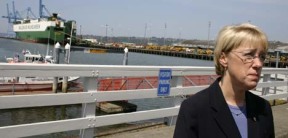Federal, state and city officials gathered Friday on the Tacoma tideflats to announce the Port of Tacoma has been selected as the site for a testing center aimed to scan and detect intermodal cargo for radiological materials.
According to the U.S. Department of Homeland Security, federal officials will soon begin conducting multiple projects at the Port to evaluate technology and concepts of operations for radiation detection that will scan cargo at various points in transfer from ship to rail.
If operations created at the center are successful, officials hope to replicate it at ports throughout the U.S. in an effort to prevent nuclear devices from entering the country by way of cargo aboard shipping vessels.
The announcement Friday — which was made outside Port of Tacoma headquarters as container cranes loaded cargo onto a shipping vessel, and a Coast Guard cutter patrolled waters nearby — follows passage of the SAFE Ports Act, championed by U.S. Sen. Patty Murray (D-Wash.), which was signed into law in October. The center would be funded through a $5 million earmark in the 2007 Emergency Supplemental bill which is being debated in Congress.
The SAFE Ports Act raises security standards for all cargo entering the United States, creates a streamlined system to track and monitor cargo, creates a system to resume trade after an incident, and authorizes port security grants.
“If we want to secure our ports, we have to work to develop and test new technologies and processes,” said Sen. Murray, who was flanked by uniformed personnel from Homeland Security and U.S. Coast Guard. “We know that current technologies that are effective for trucks do not necessarily work for trains. If we want to ensure that our communities and economies are safe, we need to look at cutting-edge technology and take a comprehensive approach.”
The Port was selected because it is the seventh largest container port in North America, and handles more than 70 percent of its total import cargo volume by rail at multiple intermodal rail yards. Intermodal refers to cargo that arrives at the port via ship and is then transferred onto trucks and trains for distribution throughout the United States of America.
“The deployment of radiation portal monitors can be much more challenging at seaports where cargo containers depart the port by rail,” said Vayl Oxford, director of the Domestic Nuclear Detection Office (DNDO). “DNDO is particularly interested in testing the operational needs as well as evaluating innovative technical solutions to fit the unique radiological and nuclear detection requirements of intermodal terminals. Advances in this area will provide greater capabilities to our partners such as the Customs and Border Protection, the United States Coast Guard and the Transportation Security Administration.”
Timothy J. Farrell, the port’s executive director, praised efforts to address port security while also preserving the efficiencies and recognizing the importance associated with intermodal shipping. “In the years to come, [this center] will help ensure the efficiency of our transportation system and add to the security of our cargo supply chain,” said Farrell.
Port security in Washington State has drawn most of Sen. Murray’s attention.
The senator secured $295 million for port security initiatives in the Emergency Supplemental Appropriations bill. She also secured $18 million in port security grants for Washington state ports, including over $11 million for critical security improvements at the Port of Tacoma.
“With this center, we have the opportunity to continue our state’s long history as the birthplace of innovation and technological breakthrough,” said Sen. Murray. “It is only fitting that the radiation detection equipment that could protect all of our nation’s ports will have its roots right here in Tacoma.”







